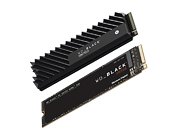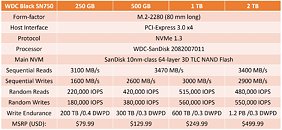- Joined
- Oct 9, 2007
- Messages
- 47,670 (7.43/day)
- Location
- Dublin, Ireland
| System Name | RBMK-1000 |
|---|---|
| Processor | AMD Ryzen 7 5700G |
| Motherboard | Gigabyte B550 AORUS Elite V2 |
| Cooling | DeepCool Gammax L240 V2 |
| Memory | 2x 16GB DDR4-3200 |
| Video Card(s) | Galax RTX 4070 Ti EX |
| Storage | Samsung 990 1TB |
| Display(s) | BenQ 1440p 60 Hz 27-inch |
| Case | Corsair Carbide 100R |
| Audio Device(s) | ASUS SupremeFX S1220A |
| Power Supply | Cooler Master MWE Gold 650W |
| Mouse | ASUS ROG Strix Impact |
| Keyboard | Gamdias Hermes E2 |
| Software | Windows 11 Pro |
Western Digital over the weekend refreshed its high-end client-segment SSD lineup with the WD Black SN750. Built in the M.2-2280 form-factor with PCI-Express 3.0 x4 interface and support for the NVMe 1.3 protocol, the drive combines a refreshed in-house developed controller with SanDisk-made 64-layer 3D TLC NAND flash memory, cushioned by up to 2 GB of DRAM cache. The biggest change this drive offers over last Summer's WD Black 3D series, however, is the optional aluminium heatsink originally made by EK Waterblocks, which improves the drive's thermals and possibly sustained performance. You can opt to buy the drive without this heatsink.
Available in capacities of 250 GB for $80, 500 GB for $130, 1 TB for $250, and 2 TB for $500, the WD Black SN750 offers sequential transfer rates of up to 3470 MB/s reads on the 500 GB and 1 TB models. The 250 GB model reads at up to 3100 MB/s, and the 2 TB model up to 3400 MB/s. Sequential write speeds, too, are improved across the board, with up to 3000 MB/s for the 1 TB model, up to 2900 MB/s for the 2 TB model, up to 2600 MB/s for the 500 GB model, and up to 1600 MB/s for the 250 GB model. 4K random-access numbers can be as high as 515,000 IOPS reads. All models are backed by 5-year product warranties.


View at TechPowerUp Main Site
Available in capacities of 250 GB for $80, 500 GB for $130, 1 TB for $250, and 2 TB for $500, the WD Black SN750 offers sequential transfer rates of up to 3470 MB/s reads on the 500 GB and 1 TB models. The 250 GB model reads at up to 3100 MB/s, and the 2 TB model up to 3400 MB/s. Sequential write speeds, too, are improved across the board, with up to 3000 MB/s for the 1 TB model, up to 2900 MB/s for the 2 TB model, up to 2600 MB/s for the 500 GB model, and up to 1600 MB/s for the 250 GB model. 4K random-access numbers can be as high as 515,000 IOPS reads. All models are backed by 5-year product warranties.


View at TechPowerUp Main Site








